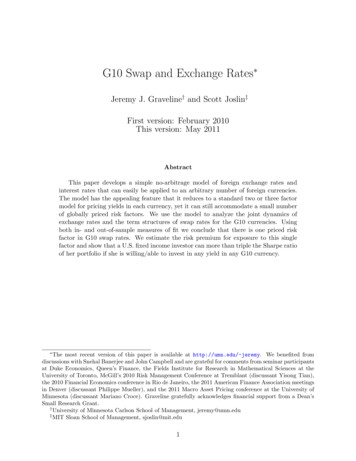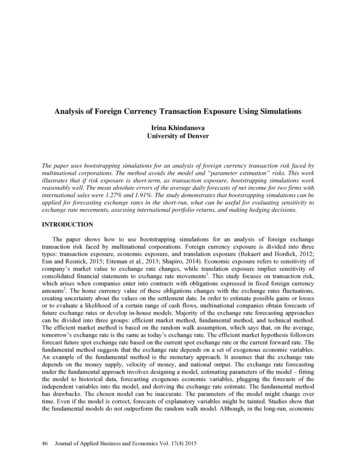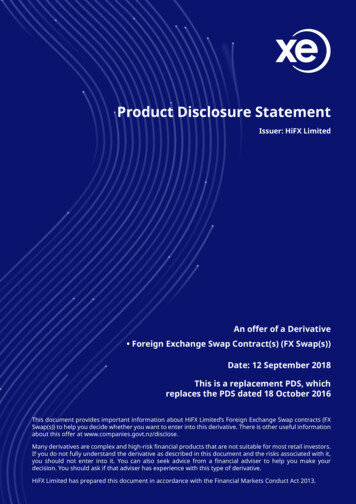
Transcription
G10 Swap and Exchange Rates Jeremy J. Graveline† and Scott Joslin‡First version: February 2010This version: May 2011AbstractThis paper develops a simple no-arbitrage model of foreign exchange rates andinterest rates that can easily be applied to an arbitrary number of foreign currencies.The model has the appealing feature that it reduces to a standard two or three factormodel for pricing yields in each currency, yet it can still accommodate a small numberof globally priced risk factors. We use the model to analyze the joint dynamics ofexchange rates and the term structures of swap rates for the G10 currencies. Usingboth in- and out-of-sample measures of fit we conclude that there is one priced riskfactor in G10 swap rates. We estimate the risk premium for exposure to this singlefactor and show that a U.S. fixed income investor can more than triple the Sharpe ratioof her portfolio if she is willing/able to invest in any yield in any G10 currency. The most recent version of this paper is available at http://umn.edu/ jeremy. We benefited fromdiscussions with Snehal Banerjee and John Campbell and are grateful for comments from seminar participantsat Duke Economics, Queen’s Finance, the Fields Institute for Research in Mathematical Sciences at theUniversity of Toronto, McGill’s 2010 Risk Management Conference at Tremblant (discussant Yisong Tian),the 2010 Financial Economics conference in Rio de Janeiro, the 2011 American Finance Association meetingsin Denver (discussant Philippe Mueller), and the 2011 Macro Asset Pricing conference at the University ofMinnesota (discussant Mariano Croce). Graveline gratefully acknowledges financial support from a Dean’sSmall Research Grant.†University of Minnesota Carlson School of Management, jeremy@umn.edu‡MIT Sloan School of Management, sjoslin@mit.edu1
1IntroductionThis paper develops a simple no-arbitrage model of foreign exchange rates and interest ratesthat can easily be applied to an arbitrary number of foreign currencies and term structures.The model we develop has two particularly appealing features. First, it reduces to a standardtwo or three factor affine term structure model for pricing yields with different maturitiesin each currency. Second, although the number factors in the model can grow large withthe number of foreign currencies and term structures, the number of priced risk factors canremain small.We use weekly data from 1993 to 2001 to estimate our multi-currency model of the jointdynamics of exchange rates and the term structures of swap rates for the G10 currencies.Using the period from 2002 until March 2009 as an out-of-sample test, we find that our tencurrency model with a single priced risk factor is better able to predict changes in yieldscompared with ten single-currency models that are each solely designed to explain changesin that currency’s yields. Our empirical estimates illustrate that the information in globalswap markets can be used in a parsimonious manner to improve our predictions of changesin the yield curves of individual the countries.We also use the model to examine the risk/reward tradeoff that is available to globalfixed income investors who are able to invest in any zero-coupon bond in any of the G10currencies. An investor who only holds U.S. zero-coupon bonds (but can use the yields onzero-coupon bonds in the other nine currencies to help predict changes in U.S. interest rates)can more than triple her expected excess return for a given level of volatility if she is ableto hold foreign currencies and zero-coupon bonds in her portfolio.Our paper provides a significant extension to the growing literature on two-currency termstructure models.1 To our knowledge, Hodrick and Vassalou (2002) was the first paper toempirically analyze a multi-currency term structure model. They examine whether shortterm interest rates in the U.S., Germany, Japan, and Britain can help to predict changes inthe exchange rates and short-term interest rates (up to one year). Our paper differs alonga couple of important dimensions. Most importantly, Hodrick and Vassalou (2002) assumethat exchanges rates and interest rates are both driven by the same sources of variation.2However, Brandt and Santa-Clara (2002), Graveline (2006), and Leippold and Wu (2007)all emphasize that changes in exchange rates are largely independent of changes in interestrates, and our model accommodates this well-documented feature of the data. Second, weconsider the full term structure of interest rates out to ten years in maturity so that ourmodel must simultaneously account for risk premia on both long-term bonds and currencies.Our model uses an affine framework (e.g., see Dai and Singleton (2000)) which differsslightly from the multi-currency quadratic term structure model developed Leippold and Wu1Recent examples of two-currency term structure models include Backus et al. (2001), Brandt and SantaClara (2002), Ahn (2004), and Graveline (2006). Bansal (1997) and Brennan and Xia (2006) discuss multicurrency and two-currency term structure models respectively, but empirically they analyze single-currencymodels and do not consider the joint dynamics of interest rates in different currencies.2Bansal (1997), Backus et al. (2001), and Brennan and Xia (2006) also assume that exchange rates andinterest rates are both driven by the same sources of variation so that currencies are spanned by bonds.2
(2007).3 Again, our paper differs along a couple of more important dimensions. First, wedraw a clear distinction between the total number of risk factors (sources of uncertainty) andthe number of linear combinations of those factors that are priced. This distinction is quiterelevant because the number of sources of uncertainty must necessarily grow large when themodel is used to analyze the joint dynamics of many currencies and yield curves, howeverbasic economic intuition suggests that each risk factor should not be independently priced.The second important distinction in our paper is that the model remains tractable so thatwe are able to empirically analyze the joint dynamics of the G10 currencies and yields curvesin a no-arbitrage framework. By contrast, Leippold and Wu (2007) empirically implement atwo-currency version of their model to analyze the U.S. and Japan.More recently, Diebold et al. (2008) and Jotikasthir et al. (2010) have also analyzedthe joint dynamics of yield curves in multiple currencies. Diebold et al. (2008) provide astatistical analysis of the joint dynamics of yield curves in Germany, Japan, the U.K. andthe U.S., and use a Nelson and Siegel (1987) approach to parameterize the cross-section ofyields. They do not model the relevant exchange rates and do not use a pricing kernel (i.e.they do not enforce no-arbitrage). Jotikasthir et al. (2010) also model the joint dynamics ofyields in the U.S., the U.K., and Germany. They do not explicitly analyze exchange rates,but implicitly their model assumes that exchanges rates and interest rates are both drivenby the same sources of variation (i.e. exchange rates are spanned by bonds).Finally, our paper is related to papers such as Ang and Chen (2010) and Lustig et al.(2011) who analyze the returns to portfolios of currencies. Lustig et al. (2011) form currencyportfolios based on the difference in short-term interest rates across currencies, while Ang andChen (2010) form currency portfolio based on changes in interest rates and term spreads.We use our model to analyze the optimal growth portfolio when investors can invest inboth currencies and swaps (bonds) with different maturities across the G10. Moreover, ourframework imposes a small number of priced portfolios with time-varying prices of risk acrossboth currencies and swaps. Our analysis of the optimal growth portfolio also relates to workby Glen and Jorion (1993), Campbell et al. (2003), and Campbell et al. (2010) who analyzethe diversification benefits of currencies of foreign bonds.The remainder of the paper is organized as follows. Section (2) develops our arbitragefree econometric model, Section (3) discusses our estimation method and empirical results,and Section (4) concludes.2Econometric ModelOur econometric model for exchange rates and interest rates in multiple currencies drawsheavily on the insights from single-currency affine term structure models, so we begin with areview of these models in a continuous-time diffusion setting as described in Duffie and Kan(1996) and Dai and Singleton (2000).3Bakshi et al. (2008) also develop and analyze a dynamic multi-currency model but they do not modelinterest rate dynamics.3
2.1Single-Currency Affine Term Structure ModelsLet Mt be the minimum variance pricing kernel and rt be the (instantaneous) risk-free shortinterest rate. The standard single-currency affine term structure model described by Duffieand Kan (1996) isrt ρ0 ρ1 · Xt ,d X, X t (H0 H1 · Xt ) dt,Et [dXt ] d hX, log M it (θ KXt ) dt, {z} (1a)(1b)(1c)EQt [dXt ]where d h·, ·it denotes quadratic variation (i.e. instantaneousand H0 H1 · Xtih covariance)T· 1 be the price at time t ofis symmetric and positive semi-definite. Let Pt (T ) Et MMta zero-coupon bond that pays 1 at time T and let Yt (T ) [log Pt (T )] / (T t) be itscontinuously-compounded yield. Yields are affine (and prices are exponential affine) in thestate vector Xt sincePt (T ) eAT t BT t ·XtYt (T ) AT t / (T t) [BT t / (T t)] ·Xt , {z} {z} ÃT t(2a)B̃T twhereBτAττ 1 ρ1 K Bu Bu H1 · Bu du,20 Z τ 1 ρ0 θ · Bu Bu H0 Bu du,20Z (2b)(2c)Let Pt be a vector of zero-coupon bond prices with different maturities and let A andB be the model-implied vector and matrix from equation (2) such that log Pt A BXt .Then expected returns on zero-coupon bonds areEt [dPt ] Pt [rt dt d hlog P, log M it ] dt Pt [rt dt B d hX, log M it ] .(3)Researchers typically model the risk premium, or quadratic variation of the state vector withthe pricing kernel, as also being affine in the state vector d hX, log M it (Λ0 Λ1 Xt ) dt.4(4)4This specification uses an extended affine price of risk from Cheridito et al. (2007) which is an extensionof the essentially affine price of risk in Duffee (2002) and the completely affine price of risk in Dai andSingleton (2000). With this specification, the true drift (and not just the risk-neutral drift in equation (1c))is affine sinceEt [dXt ] Et [dXt ] d hX, log M it d hX, log M it .Only the risk-neutral drift is required to be an affine function of the states for the yields to also be affine inthe states.4
Together, equations (1) and (4) constitute a single-currency term structure model. Anyaffine transformation of the state vector produces a model of the same form, so all of theparameters are not uniquely identified. Dai and Singleton (2000) provide a canonical representation (affine transformation) of single-currency affine term strucuture models and alsodiscuss the parameter restrictions that are required to ensure that the elements of the statevector that govern stochastic volatility (i.e. those elements of Xt with non-zero weights inH1 ) remain positive. Our empirical implementation uses a Gaussian model (i.e. H1 0)so we do not discuss the necessary parameter restrictions for specifications with stochasticvolatility. Also, we do not discuss the various canonical representations because we followDuffie and Kan (1996) and fix the affine transformation of the model so that the factors arespecific linear combinations of zero-coupon yields.To be specific, let Yt be a K-dimensional vector of zero-coupon yields with differentmaturities and define the state vector as Xt L0 L1 Yt , where L0 is N 1 and L1 is N Kfor N K. We can write Yt à B̃Xt , where à and B̃ are K 1 and K N matrices thatare determined by the model parameters (ρ0 , ρ1 , θ, K, H0 , and H1 ) according to equation(2). No arbitrage provides N (N 1) parameter restrictions since Xt L0 L1 Yt L0 L1 à B̃Xt L0 L1 à 0 and L1 B̃ I.(5)In the empirical implementation it is important to choose the state vector to be a linearcombination of yields that can account for much of the cross-sectional variation in yields.We know from previous literature (e.g., Litterman and Scheinkman (1991)) that the first3 principal components of changes in each country’s yield curve account for most of thevariation along the yield curve. Therefore, in our estimations we choose the state vector tobe the first 2 or 3 principal components (depending upon data availability) of yields in eachcurrency.5 For the yield curves of the G10 countries that we model in this paper, the first3 principal components of changes in each country’s yield curve are very closely related tochanges in the level, slope, and curvature of yields in that currency.We make a small but important modification to the standard model to reflect the empirical work of Cochrane and Piazzesi (2005). They find that one linear combination of yields(equivalently, forward rates) does a good job of predicting excess returns of bonds with different maturities. Moreover, this linear combination is not well-spanned by the first 3 principalcomponents of yields. We incorporate this finding into the risk premia specification as follows d hX, log M it (Λ0 Λ1 Yt ) dt,such that rank ([Λ0 , Λ1 ]) 1.6The rank restriction in equation (6) means that Λ0 Λ1 Yt Λ L̃0 L̃1 · Yt5(6)(7)A common approach to estimating term structure models is to follow Chen and Scott (1993) and assumethat the model prices a subset of yields exactly and the remaining yields are priced with error. With thisestimation approach, the state vector is an affine function of the yields that are assumed to be priced exactly.Our approach is a slight generalization of this technique in that we effectively assume that the model correctlyprices an affine function of yields rather than a specific subset of yields. See also Joslin et al. (2010b) for adiscussion of this approach.6Joslin et al. (2010a) also use a rank restriction on risk premia.5
for some N 1 vector Λ, constant L̃0 , and K 1 vector L̃1 .In theory, if our model was perfect then it would correctly price all of the yields andthere would be no new information in L̃0 L̃1 · Yt that was not already contained in the statevector Xt , L̃0 L̃1 · Yt L̃0 L̃1 à B̃Xt L̃0 L̃1 à L̃1 B̃Xt .(8)In practice, the model is not perfect and only prices the state vector Xt L0 L1 Yt withouterror. Therefore all of the yields outside of this span, including L̃0 L̃1 · Yt , will be pricedwith error, Yt à B̃Xt εt L̃0 L̃1 · Yt L̃0 L̃1 à L̃1 B̃Xt L̃1 εt .(9)Although the model does not perfectly price the entire cross-section Yt of yields with differentmaturities, they are still observable at time t and therefore we can include them in the model.Intuitively, it is convenient to reduce the state space to XT Xt when constructing the modelimplied distribution of changes yields YT Yt at a future dates T t. However, at time t weobserve the contemporaneous cross-section Yt of yields so there no benefit to conditioningdown the state space to Xt and ignoring the information in the model’s cross-sectional pricingerrors.To conclude, the multi-currency model that we develop in the next section draws heavilyon the following single-currency model,rt ρ0 ρ1 · Xt ,d X, X t H0 dt,Et [dXt ] d hX, log M it (θ KXt ) dt,(10a)(10b)(10c)Xt L 0 L 1 Yt ,(10d) whereand L0 and L1 are the weights from the first 2 or 3 principal components of changes in yields.Also, in our single-currency model risk premia are governed by d hX, log M it (Λ0 Λ1 Yt ) dt, ΛX̃t dt,such that rank ([Λ0 , Λ1 ]) 1,(11a)(11b)whereX̃t L̃0 L̃1 · Yt(11c)and L̃0 is a constant and L̃1 is a vector with the same length as the vector of yields Yt .We apply this same style of single-currency model to the term structure of interest rates(i)in foreign currencies. Let St be country i’s exchange rate expressed in units of domestic(i)currency per unit of foreign currency i and let rt be the risk-free short interest rate in that(i)currency. If Yt is a K (i) -dimensional vector of zero-coupon yields in foreign currency i then6
the equivalent term structure model is(i)rtd X (i) , X (i) h(i)Et dXti d X (i) , log M S (i)tt(i)(i)(i) ρ 0 ρ 1 · Xt , (i)H0 (12a)dt,(12b)(i)θ(i) K(i) Xt dt, 7(12c)where(i)(i)(i)(i)Xt L0 L1 Yt ,(i)(12d)(i)and L0 and L1 are the weights from the first 2 or 3 principal components of changes inyields in foreign currency i. Similarly, risk premia are governed by hi (i)(i) (i)(i)(i)dt, rank Λ0 , Λ1 1,(15a) d X (i) , log M S (i) t Λ0 Λ1 Yt(i) Λ(i) X̃t dt,(15b)where(i)(i)(i)(i)X̃t L̃0 L̃1 · Yt(i)(15c)(i)(i)and L̃0 is a constant and L̃1 is a vector with the same length as the vector of yields Yt .2.2Multi-Currency ExtensionThe most general multi-currency affine model with I foreign currencies and term structureshas the same form as the single-currency model in equations (1) and (4),* d XX,log Slog Srt(i)rt ρ 0 ρ 1 · Xt , (i)ρ0 (i)ρ1· Xt ,(16a)i 1, . . . , I, H0 H1 · Xt ,(16b)(16c)tEt [dXt ] d hX, log M it (θ KXt ) dt, 8 XX d, log M Λ0 Λ1,log Slog S tt7(16d)(16e)If M is the pricing kernel denominated in the domestic currency thenMt Zt Et [MT ZT ] ,(13)for any asset price Z in the domestic currency. If S (i) is country i’s exchange rate expressed in units ofdomestic currency per unit of foreign currency i then Z/S (i) is the asset’s price in foreign currency i andM S (i) is the associated pricing kernel sinceih(i)(i)(i)(i)Mt St Zt /St Mt Zt Et [MT ZT ] Et MT ST ZT /ST .(14)7
where log St log S (1) , . . . , log S (I) t is a vector of the log exchange rates. From a practicalstandpoint, the dimension of the state vector must grow with the number of exchange ratesand term structures the model is designed to capture. The size of the parameter space ofthe most general multi-currency term structure model is proportional to the cubed lengthof the state vector (without stochastic volatility it’s proportional to the squared length ofthe state vector). Therefore, as the number of currencies and term structures in a multicurrency model grows, the most general model can quickly become impractical to estimate.We develop a simple and tractable multi-currency model that draws on two key insights.First, single-currency term structure models typically have low cross-sectional pricing errorsand multi-currency models should inherit this feature. Second, the number of priced riskfactors in the model does not need to grow with the size of the state vector.Our empirical implemenation works with a domestic term structure plus nine foreigncurrencies and term structures, but the approach is easy to generalize to an arbitrary number.Let Xt L0 L1 Yt be the affine function of yields that serves as the state vector for the(i)(i)(i) (i)domestic single-currency term structure model. Similarily, let Xt L0 L1 Yt be thestate vectors for the single-currency term structure models in foreign currencies i 1, . . . , I.(i)Again, St is foreign currency i’s exchange rate expressed as units of domestic currency perunit of foreign currency i.(1)(I)(1)The state vector in our multi-currency model consists of Xt , Xt , . . ., Xt and log St ,(I). . ., log St . We model the second moments (quadratic variation) of this state vector asconstants (Gaussian) so that H··········0XX .(1)(1) · X (1) X (1)H0··· ·C0 · · · . . . . . .* . . . · . (I) (I)(I)(I) ·d X , X·· · · H0·· · · C0 dt, (17a) (1) (1) (1) logSlogS · ··· ····· ·C0 . . . . . . . . . . . .(I) log S (I)log S (I)t··· · · C0···· ·(i)The single-currency models also require H0 : d X, X t /dt and H0 : d X (i) , X (i) t /dt.To conserve notation, we have used a simple dot to denote most of the other parametersof the matrix of second moments. As we’ll see shortly, these parameters do not affect thecross-section of yields in our model so they are free to capture co-variation in the elementsof the state vector. Although it does not restrict the cross-section of yields, we have ex(i)plicitly labeled C0 d X (i) , log S (i) t /dt because it is relevant below when changing fromthe risk-neutral measure in foreign currency i to the risk-neutral measure in the domesticcurrency.hihi(i)(i)(i)The risk-neutral drift of foreign currency i’s exchange rate must be Et dSt St rt rt dt.Therefore one can model either the short-interest rate in foreign currency i or the risk-neutral drift of thatcurrency’s exchange rate, but not both.88
To complete the cross-sectional pricing implications for the model, we also need to specifythe dependence of the short interest rates on the state vector, ρ0···0ρ1rX0 (1) .(1) . . r(1) ρ(1) X . .0 ρ1 0 .(17b) . . . ,. . . . . 0 .(I)(I)r(I) tX (I) tρ00 ··· 0ρ1as well as the risk-neutral drift of the state vector XX* X (1) X (1) Et d . d . , log M . . X (I) tθ(1)(1)θ C0.(I)θ(I) C0 X (I)K 00.K(1).···.0···0t0.0K(I) XX (1).X (I)(17c) dt. tOur simple restricted setup in equation (17) has the appealing feature that the cross-sectionof zero-coupon yields in each currency are the same as the individual single-currency modelswhich typically capture the cross-section of yields with different maturities very well. Moreover, the only new parameters in equation (17) are the additional elements of the matrix ofsecond moments that capture co-variation in the combined state vector.(i)We have chosen Xt as an affine function of domestic yields and each Xt as an affinefunction of yields in foreign currency i. For the domestic currency and seven of the foreigncurrencies we choose the state vector to be the first three principal components of changesin yields. Due to data restrictions, the state vectors for the remaining two foreign currenciesare the first two principal components of changes in yields. Therefore, when we include theno-arbitrage restrictions from equation (5), our restricted model has 8 3 4 2 2 3 108free parameters in equations (17b) and (17c).One could instead use the most general model and allow each element of the state vector(excluding the log exchange rates) to be an affine function of yields in all of the currenciesrather than just a single currency. This approach would allow greater flexibility in matchingthe cross-section of yields in each currency at the expense of adding many more parameters.For example, if we relaxed the zero restrictions in equations (17b) and (17c) but maintaineda 28-dimensional state vector (excluding the log exchange rates) then the unrestricted modelwould have 28 29 812 free parameters in equations (17b) and (17c). Single-currencymodels typically capture the cross-section of yields with different maturities very well, sothere is little room for benefit from the large number of additional parameters. One couldalso use the unrestricted model with a lower dimensional state vector. For example, if wechose the state vector (excluding the log exchange rates) to be the first ten PCs of changes inyields of all currencies then the unrestricted model would have 10 11 110 free parameters9
in equations (17b) and (17c).9 The clear benefit of our approach is that all of the parametersin equations (17b) and (17c) have direct counterparts in the single-currency term structuremodels, so they are very easy to estimate. Secondly, it is very easy to add additionalcurrencies and term structures to the model because we simply expand the state vector toinclude affine functions of yields in those currencies.To complete the model, we need to specify risk premia, or equivalently, the quadraticvariation of the state vector with the pricing kernel. The second key insight of our modelis that the size of the state vector can grow large as the model incorporates more foreigncurrencies and term structures, but the number of priced risk factors does not need toincrease. We use the same approach as the single-currency models and restrict the numberof priced risk factors in the model by constraining the rank of the risk premia parameters, X X (1) .X̃ * . X̃ (1) (I) (18) d X dt, rank ([Λ0 , Λ1 ]) R. , log M Λ0 Λ1 . . (1) logS .X̃ (I) t .log S (I)tX̃t L̃0 L̃1 · Yt is from the specification in equation (11) of the single-currency risk premia(i)(i)(i)(i)for the domestic currency and X̃t L̃0 L̃1 · Yt is from the specification in equation(15) of the single-currency risk premia for foreign currency i. Intuitively, risk premia in ourmulti-currency model depend on the individual affine functions of yields in each currencythat best predict excess bond returns in that currency. In our empirical analysis, we examinethe performance of the model both in- and out-of-sample with different numbers of pricedrisk factors. The rank restrictions in equation (18) have both an economic and statisticalrole. From an economics standpoint, it is logical to work with a relatively small numberof priced risk factors. Intuitively, although one may need to model the joint dynamics ofhundreds of prices, it makes little economic sense to all each of the source of uncertainty tobe priced.From a statistical standpoint, risk premia are notoriously difficult to estimate so againit is instructive to examine the number of free parameters under different specifications.When we model the G10 currencies and term structures, the state vector on the left handside of equation (18) is 37-dimensional and the state vector on the right hand side is 10dimensional. If there is one priced risk factor (i.e. R 1) then there are 37 10 47 freeparameters in equation (18). If there are two priced risk factors (i.e. R 2) then there9Note that the number of free parameters in equation (17a) would be reduced from 37 38/2 703 to19 20/2 190 if we reduced the dimension of the state vector (including the log exchange rates of the nineforeign currencies) from 37 to 19. However, this reduction in free parameters can be misleading because onestill has to estimate the full matrix of second moments in order to determine the state vector. For example,if we were to choose the state vector to be the first ten PCs of changes in yields of all currencies then wewould still need to estimate the full matrix of second moments of yields in order to determine the PC weightson each yield.10
are 2 (37 9) 92 free parameters. If there are three priced risk factors then there are3 (37 8) 135 free parameters, and so on. If we used the same 37-dimensional statevector on the right hand side of (18) then with one priced risk factor there are 37 37 74free parameters. With two priced risk factors there are 2 (37 36) 146 free parameters,with three are 3 (37 35) 216 free parameters, and so on. With no restrictions on thenumber of priced risk factors there are 37 38 1406 free parameters! We could againconsider the possibility of reducing the dimension of the state vector. For instance, if wechose an unrestricted model with a 12-dimensional state vector (excluding the log exchangerates) then there would be 12 13 156 free parameters in equations (17b) and (17c)but with three priced risk factors there would be only 3 (21 8) 87 free parameters inequation (18) for a total of 156 87 243. The number of free parameters in these equationsis the same as our restricted model with a 28-dimensional state vector (excluding the logexchange rates) which has 108 135 243. Regardless of the dimension of the chosen statevector, it is clear from both an economic and statistical standpoint that one needs to restrictthe number of priced risk factors in the model.3Data and Estimation ResultsOur empirical implementation uses swap and exchange rate data from Bloomberg on theG10 currencies which are the U.S. dollar (USD), British pound (GBP), Japanese yen (JPY),Australian dollar (AUD), Euro (EUR), Canadian dollar (CAD), Swiss franc (CHF), NewZealand dollar (NZD), Swedish krona (SEK), and Norwegian krone (NOK). We use weekly(Wednesday) data from January 6, 1993 until March 28, 2009 and use data on the Germanmark (DEM) before the Euro was introduced. We use 3- and 6-month Libor rates and 2-, 3-,5-, 7-, and 10-year swap rates in each currency to bootstrap a zero-coupon yield curve underthe assumption that forward rates are constant between observations. For the early part ofour sample we are missing data on 7- and 10-year Norwegian swap rates and 6-month Liborand 7- and 10-year New Zealand swaps rates.We begin by estimating the single-currency term structure model in equations (10) and(11) for the U.S. dollar and the model equations (12) and (15) for the remaining nine currencies in the G10. Table 1 provides the yield loadings for the first two (NZD and NOK) orthree (the remaining eight currencies) principal components of changes in each currency’syield. We use these principal component loadings to construct the state vectors Xt L1 Yt(i)(i) (i)for the U.S. dollar and Xt L1 Yt for the other nine currencies. L1 is equal to the three(1)(2)rows in Table 1 for the USD, L1 is the three rows for GBP, L1 is the three rows for JPY,and so on. We set the constant terms in equations (10d) and (12d) to zero for each currency(i)(i.e. L0 L0 0).We use maximum likelihood to estimate the domestic single-currency model parametersρ0 , ρ1 , K, θ, H0 , Λ0 , and Λ1 from equations (10) and (11). Let à and B̃ be the yieldweightings for these parameters calculated from equation (2) so that Yt à B̃Xt . Theparameters must satisfy the no-arbitrage restrictions from equation (5) that Xt L1 Yt L
exchange rates and the term structures of swap rates for the G10 currencies. Using both in- and out-of-sample measures of t we conclude that there is one priced risk factor in G10 swap rates. We estimate the risk premium for exposure to this single factor and show that a U.S. xed income investor can more than triple the Sharpe ratio










